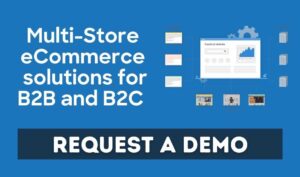If you’re a distributor, or a manufacturer, or even a retailer who caters to a wide variety of customers or different marketplaces, then you must have already realized how chaotic and perplexing it can be to handle it all from a single site or store.
You may also already be aware that a multi-store e-commerce platform allows you to launch and manage multiple stores from a single platform. If you aren’t, then you might want to check this article to know everything about a multi-store platform.
In this article, let’s take a look together at the important business applications of a multi-store e-commerce platform so that you will understand the different ways in which you can leverage them in order to increase your sales while providing a personalized experience to your customers.
5 key business applications of multi-store eCommerce platform
- Capability to run multiple sites and brands
- Handle niche eCommerce websites
- Manage multiple business models
- White-label websites
- Multimarket web stores
1. Capability to run multiple sites and brands
One of the best use cases of running multiple e-commerce stores is that an enterprise-level company can provide a unique shopping experience to all its customers through multiple brands and still not compromise on its centralized services.
Let us consider an apparel manufacturer who does business under different brand names. Each of their brands has a distinct quality and caters to different demographics.
Now imagine how chaotic and disorganized it will be if the manufacturer had to display the products of all their enterprise-level brands on a single website.
The simple solution is to create separate websites for each of these brands and effectively manage them from a master portal.
Through this, you will also be able to streamline all the processes and make the most of the features like Product Information Management, Content Management, and more.
This is one of the most common business applications of multi-store eCommerce.
2. Handle niche eCommerce websites
Running multiple storefronts provide you the flexibility to create and manage niche web stores that are category, event, and promotion-specific.
This will allow you to effectively segregate your customers and devise strategies like optimizing for search engines that are specific to those audiences and sites, rather than relying on a one-size-fits-all practice.
For example, let’s consider a distributor who does uniform business and also sells cleaning and janitorial equipment. When a customer looking to purchase uniforms for their corporate employees visits this site, they must dive through both uniform and cleaning products, potentially undergoing a bad user experience.
This poor customer experience could have been avoided if the two verticals were segregated as different storefronts.
The complexity of running different storefronts, each accommodating different categories or niches, can be simplified by streamlining all of those to a single platform.
Below are some of the top benefits of it:
- Provide clutter-free navigation to a product or category-specific customers.
- Create separate web stores for different product categories.
- Optimize keywords and stores for better positioning on the Search Engine Ranking Pages (SERP).
- Provide different shipping options for products based on their demand.
3.Manage multiple business models
The ability to manage multiple business models through a single e-commerce platform is a game-changing functionality for many businesses.
To elaborate more on it, here’s an example. Let’s say there’s a wholesaler who wants to have an option to sell their products directly to the end customer as well as sell to retailers in bulk.
In this case, the wholesaler is looking to provide through both B2B and B2C business models. This is not possible through a single website. So, two separate websites are created for these business models.
By doing this, he can create a customer-centric shopping experience through his B2C store and offer the option to order in bulk for his retail customers on the B2B store.
4. White-label websites
Manufacturers and distributors can simplify the buying experience and in turn improve the overall sales through white labeling or affiliate stores.
White labeling means having your products rebranded and sold by others while you benefit through those sales.
In this case, you may create a separate web store and supply your products to a retailer. It will be the retailer’s responsibility to market and sell your products while you still hold the power to make changes to the store through your master admin.
In this way, you may create multiple web stores and increase your overall sales by leveraging the power of a multi-store eCommerce platform.
5. Multimarket web stores
Opening multiple web stores that are geolocation-based has the advantage of providing a local shopping experience for global shoppers. This, in turn, will get higher engagement and conversions.
Let’s say that you would like to grow your business in Mexico as well as in Canada, along with your current store in the USA.
Now you cannot use the same web store to sell in Mexico and Canada as all three regions have a vast difference in aspects like culture, demographics, currency, language, shipping settings, and many more.
In this case, you need multiple stores, each for a different region. You can create your Mexican web store in the Spanish language and display the product pricing in Pesos, and also offer different product catalogs that are specific to that region.
Creating multiple storefronts specific to that region will also allow you to monitor customer behavior and offer deals and discounts based on it.
